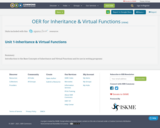
Introduction to the Base Concepts of Inheritance and Virtual Functions and its use in writing programs
- Subject:
- Career and Technical Education
- Material Type:
- Lecture
- Lecture Notes
- Date Added:
- 07/25/2016

Introduction to the Base Concepts of Inheritance and Virtual Functions and its use in writing programs

This is the first of a series of task aiming at understanding the quadratic formula in a geometric way in terms of the graph of a quadratic function.
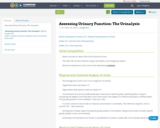
Assessing Urinary Function: The Urinalysis
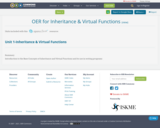
Introduction to the Base Concepts of Inheritance and Virtual Functions and its use in writing programs
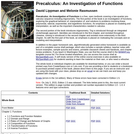
Precalculus: An Investigation of Functions is a free, open textbook covering a two-quarter pre-calculus sequence including trigonometry. The first portion of the book is an investigation of functions, exploring the graphical behavior of, interpretation of, and solutions to problems involving linear, polynomial, rational, exponential, and logarithmic functions. An emphasis is placed on modeling and interpretation, as well as the important characteristics needed in calculus.
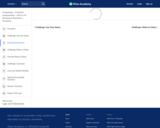
Pamela shows how you can pass parameters into custom functions, so that they can behave differently each time you call them.
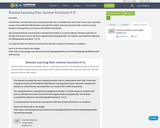
This Remote Learning Plan was created by Jennifer Gier in collaboration with Tyler Cronin and Craig Hicks as part of the 2020 ESU-NDE Remote Learning Plan Project. Educators worked with coaches to create Remote Learning Plans as a result of the COVID-19 pandemic.The attached Remote Learning Plan is designed for Grades 7-12 math students. Students will learn to identify and create inverse functions algebraically and graphically. This Remote Learning Plan addresses the following NDE Standard: 11.2.1hIt is expected that this Remote Learning Plan will take students 90 minutes to complete.Here is the direct link to the Google Slide: https://docs.google.com/presentation/d/1Jp2zJ3gAt4VqOFCJc1z3vk7Zr0hstKgGhgsqDnbBHDw/edit?usp=sharing
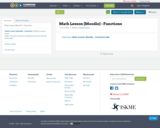
Math Lesson (Moodle) - Functions

Generalizing a linear consumption function as a function of aggregate income. Created by Sal Khan.

This lesson presents an overview of the importance of plants; the main parts of a plant; the types of each of the plant parts; and the relationship of each part to fruits, nuts, and vegetables. This represents a portion of the Introduction to Agriculture, Food, and Natural Resources (AFNR) series in Nebraska middle and high school agricultural education.
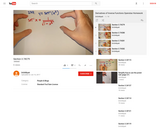
Derivatives of Inverse Functions (Openstax Homework).
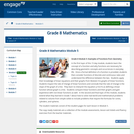
In the first topic of this 15 day module, students learn the concept of a function and why functions are necessary for describing geometric concepts and occurrences in everyday life. Once a formal definition of a function is provided, students then consider functions of discrete and continuous rates and understand the difference between the two. Students apply their knowledge of linear equations and their graphs from Module 4 to graphs of linear functions. Students inspect the rate of change of linear functions and conclude that the rate of change is the slope of the graph of a line. They learn to interpret the equation y=mx+b as defining a linear function whose graph is a line. Students compare linear functions and their graphs and gain experience with non-linear functions as well. In the second and final topic of this module, students extend what they learned in Grade 7 about how to solve real-world and mathematical problems related to volume from simple solids to include problems that require the formulas for cones, cylinders, and spheres.
Find the rest of the EngageNY Mathematics resources at https://archive.org/details/engageny-mathematics.
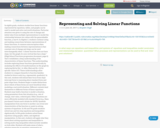
In eighth grade, students studied how linear functions represented by equations, tables, and graphs can be used to model and solve real world situations. Particular attention was given to using the rate of change and initial value from multiple representations to model the relationship between two values with the generalizable function, y=mx+b. In Algebra 1, students continue using and making connections between representations of linear functions. A common misconception when making connections between representations is that constant rate of change and slope can be used interchangeably when “a linear function does not have slope, but the graph of a non-vertical line has a slope.” (High School Functions progression document, page 6) Unit 2 establishes a deep understanding of the characteristics of linear functions. This understanding includes exploring linear functions geometrically by analyzing the effects of transformations on the graph by replacing f(x) by f(x) + k, kf(x), f(kx) and f(x + k) for specific values of k. These understandings allow students to compare linearity to function families studied in future units (e.g., exponential, quadratic).
In this unit, students will extend their focus from slope intercept form to reasoning about standard form and point slope form. Students begin to make distinctions about which of these forms are most beneficial when modeling a real world situation. Different contexts lend themselves to different forms of linear equations. Students may build a function to model a situation, using parameters from that situation (e.g., rate of change, start value, ordered pair). Other situations are more efficiently modeled with standard form (e.g., Dana purchased 3 brauts and 4 drinks for $8.50). Symbolic manipulation from one form to another can reveal new characteristics of the function or assist in solving systems of equations.
In 6th and 7th grade students solved one and two step equations and inequalities algebraically. In 8th grade students solved linear equations using graphs, tables, and algebraic manipulation. In this unit, students will apply what they know about solving equations and inequalities to solving multi-step inequalities which include variables on both sides. Students will make sense of what a solution means for an equation compared to an inequality. Students will extend their understanding of solving linear equations with two variables. First, they will manipulate equations to solve for specific variables. Second, students will justify their reasoning by supplying mathematical properties to explain each step in solving an equation. This work will help set the groundwork for mathematical proofs in tenth grade.
In addition, students will extend their 8th grade understanding of solving systems of linear equations to include systems of linear inequalities as representations of real world situations. Students will solve systems of linear equations exactly (e.g. with substitution principle, combination/elimination), and approximately (e.g., with graphs) with a new emphasis on the conceptual understanding and justification of why these strategies work. Students will compare and contrast the benefit of using each of these strategies in different situations.
In this unit students are using what they know about linear functions to build new understandings of piecewise linear functions including absolute value functions. In addition, students will use tables and graphs to solve absolute value equations as described in HSA.REI.D.11. The Michigan State Standards no longer require students to be able to algebraically solve piecewise and absolute value functions.
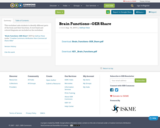
This worksheet asks students to identify different parts of the brain and their functions. A word bank and colored diagrams are included on the worksheet.
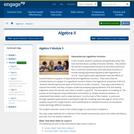
"In this module, students synthesize and generalize what they have learned about a variety of function families. They extend the domain of exponential functions to the entire real line (N-RN.A.1) and then extend their work with these functions to include solving exponential equations with logarithms (F-LE.A.4). They explore (with appropriate tools) the effects of transformations on graphs of exponential and logarithmic functions. They notice that the transformations on a graph of a logarithmic function relate to the logarithmic properties (F-BF.B.3). Students identify appropriate types of functions to model a situation. They adjust parameters to improve the model, and they compare models by analyzing appropriateness of fit and making judgments about the domain over which a model is a good fit. The description of modeling as, the process of choosing and using mathematics and statistics to analyze empirical situations, to understand them better, and to make decisions, is at the heart of this module. In particular, through repeated opportunities in working through the modeling cycle (see page 61 of the CCLS), students acquire the insight that the same mathematical or statistical structure can sometimes model seemingly different situations.
Find the rest of the EngageNY Mathematics resources at https://archive.org/details/engageny-mathematics."
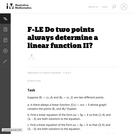
This task is designed as a follow-up to the task F-LE Do Two Points Always Determine a Linear Function? Linear equations and linear functions are closely related, and there advantages and disadvantages to viewing a given problem through each of these points of view. This task is intended to show the depth of the standard F-LE.2 and its relationship to other important concepts of the middle school and high school curriculum, including ratio, algebra, and geometry.

Description
Overview: Area: Plants and Animals
A central feature of life is that organisms grow, reproduce, and die. They have characteristic structures (anatomy and morphology), functions (molecular-scale processes to organism-level physiology), and behaviors (neurobiology and, for some animal species, psychology). Organisms and their parts are made of cells, which are the structural units of life and which themselves have molecular substructures that support their functioning. Organisms range in composition from a single cell (unicellular microorganisms) to multicellular organisms, in which different groups of large numbers of cells work together to form systems.

Desmos activities are interactive, math based activities that can be altered to fit your needs. This particular Desmos activity works through inverses of linear equations for Secondary Math III students.
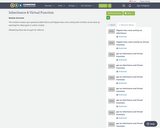
This module contains quiz questions( READ ONLY) and Flipped Class room activity both of which can be done by watching the videos given in author modulefollowed by these two are ppts for refernce
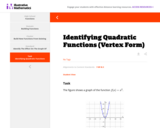
This task has students explore the relationship between the three parameters a, h, and k in the equation f(x)=a(x−h)2+k and the resulting graph. There are many possible approaches to solving each part of this problem, especially the first part. We outline some of them here (which overlap heavily in places), applied to the top left graph, and then only give the final answers in the solution provided.